 |
 |
 |
 |

 Modern
Orthodontic appliances very efficiently move teeth, but most often myofunctional
habits go untreated, slowing treatment and compromising stability.
Modern
Orthodontic appliances very efficiently move teeth, but most often myofunctional
habits go untreated, slowing treatment and compromising stability.
Class II correction is unpredictable even with the best techniques. Research has proven repeatedly that muscle will always overpower the hard tissues (teeth and alveolar bone).
Now it is possible to treat the myofunctional aspects of the malocclusion as well as the dental and skeletal structures with the T4BĘ.
Combine fixed and functional phases
Functional appliances are often needed as part of Orthodontic (Phase 1) therapy, particularly for Class II correction. However, they do extend treatment time. If the patient is ready for fixed appliance therapy, functional Phase 1 therapy is often omitted.
The T4BĘ allows for functional and fixed appliance phases simultaneously. The advantages of both treatment approaches are achieved in a shorter treatment time.
Break myofunctional bad habits
Myofunctional habits such as tongue thrusting, reverse swallowing, and mouth breathing contribute to many malocclusions. These aberrant oro-muscular forces maintain the incorrect dental positions and can impede Orthodontic treatment. Relapses often result once the retainers are removed.
The T4BĘ is designed to diminish these detrimental forces by myofunctional training during fixed appliance therapy. This is achieved by the design features of the tongue tag, guard and incorporated lip bumpers.
The T4BĘ also "trains" a Class I relationship in the same way as functional or "jumper" appliances.
Myofunctional training will decrease treatment time and enhance stability.
Treat and prevent TMJ problems
 TMJ
Disorder has been shown to be prevalent in the majority of adolescent
Orthodontic patients.* This can be difficult to treat during fixed appliance
therapy. In addition, the occlusal changes produced by Orthodontic treatment
can precipitate acute TMJ symptoms.
TMJ
Disorder has been shown to be prevalent in the majority of adolescent
Orthodontic patients.* This can be difficult to treat during fixed appliance
therapy. In addition, the occlusal changes produced by Orthodontic treatment
can precipitate acute TMJ symptoms.
The T4BĘ incorporates a soft TMJ splint that is specifically designed to assist in treatment of this disorder. It has a 3.2mm thick posterior section, while the anterior section is 2mm thick for TM Joint decompression.
Bruxing limited by double mouthguard effect.
* Riolo, Brandt
& Tenhave - Associations between occlusal characteristics and signs
and symptoms of TMJ dysfunction in children and young adults.
(AM J ORTHOD DENTOFAC ORTHOP 1987;92: 467-77)
Speed up Orthodontic treatment
Using the T4BĘ in combination with fixed appliances for one hour daily plus overnight, discludes the dentition and decreases aberrant myofunctional forces on the dentition. This facilitates faster tooth movement by removing the influence of interlocking occlusal forces.
Prevent soft tissue trauma
Trauma of the soft tissue is a common problem when fixed appliances are first applied.
The T4BĘ covers the offending braces eliminating much of the trauma to the patient in those first few weeks of fixed treatment.
![]()
| Home
|
| The Pre-Orthodontic Trainer | The
Trainer for Braces |
| The TMJ Appliance | New Products
|
Patent No. 5 259 762